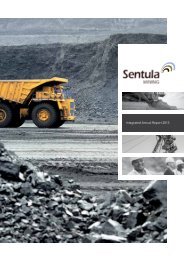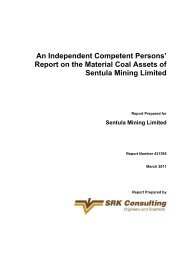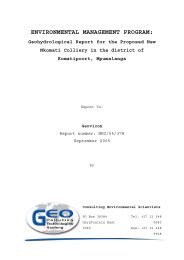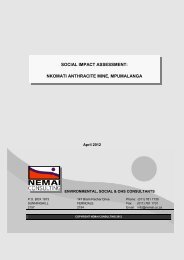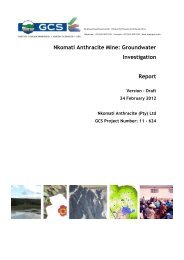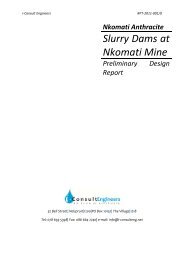NKOMATI ANTHRACITE (PTY) LIMITED - Sentula Mining
NKOMATI ANTHRACITE (PTY) LIMITED - Sentula Mining
NKOMATI ANTHRACITE (PTY) LIMITED - Sentula Mining
You also want an ePaper? Increase the reach of your titles
YUMPU automatically turns print PDFs into web optimized ePapers that Google loves.
Environmental Impact Assessment Report: Nkomati Anthracite (Pty) Limited, Madadeni Opencast<br />
<strong>Mining</strong> Project Page 73<br />
Activities Opencast mining<br />
Nature of impacts Groundwater Quantity:<br />
After closure, the water table will rise in the rehabilitated pits to reinstate equilibrium<br />
with the surrounding groundwater systems. It is estimated that the groundwater will<br />
recover to 50% of pre-mining levels in about eight years.<br />
However, the backfilled opencast areas will have a large hydraulic conductive<br />
compared to the pre-mining situation. This will result in a relative flattening of the<br />
groundwater table over the extent of the rehabilitated opencast, in contrast to the<br />
gradient that existed previously. The end result of this will be a permanent lowering<br />
of the groundwater level in the higher topographical area and a rise in lower lying<br />
areas.<br />
Intuitively, it would be expected that this raise in groundwater could result in<br />
decanting of the opencast area. Inspection of the predicted groundwater levels<br />
indicates that the post mining groundwater levels in the proposed mining area is not<br />
predicted to decant. The reason for this is that this opencast is much smaller and<br />
the rise (and decline) of post mining groundwater levels are much less pronounced,<br />
as depicted in the above-mentioned Figure 19.<br />
Groundwater Quality:<br />
Once the normal groundwater flow conditions have been re-instated, polluted water<br />
can migrate away from the rehabilitated areas. Although the overburden is mostly<br />
intermediate acid forming, some coal and discards normally remain in the pits and<br />
the outflow could thus be contaminated, as a worst case scenario.<br />
The migration of contaminated water from the mining area has been modelled as<br />
described, and the results are presented in Figure 20 to Figure 23 in terms of the<br />
extent of the pollution plume 10, 20, 40 and 80 years after the pits has been closed.<br />
Experience has shown that the plume stagnates after about 80 years, and no further<br />
movement after such time is expected.<br />
Within the limitations of the abovementioned assumptions, it can be estimated from<br />
these figures that:<br />
• Movement of the plume will be mostly downstream in the direction of the<br />
non perennial tributaries of the Komati River, as can be expected.<br />
• However, the movement of the plume is predicted to be very slow due to<br />
the low hydraulic conductivity and the low gradients in the area.<br />
• After forty years the front of the plume will have moved about 250 metres.<br />
The area where the groundwater might exceed domestic drinking water<br />
standards is expected to be about 70 metres from the pits where it will<br />
impact on the upper reach of the non perennial tributary of the Komati<br />
River.<br />
• Eighty years after closure of the opencast, the plume is predicted to impact<br />
over a wide area on the non perennial tributaries of the Komati River. By<br />
this time the plume would have moved about 250 metres.<br />
The results must be viewed with caution as a homogeneous aquifer has been<br />
assumed. Heterogeneities in the aquifer are unknown and the effect of this cannot<br />
be predicted. Furthermore, no chemical interaction of the sulphate with the minerals<br />
in the surrounding bedrock has been assumed. As there must be some interaction<br />
and retardation of the plume, it is hoped that this prediction will represent a worstcase<br />
scenario.<br />
Impact assessment Groundwater Quantity<br />
Extent Possibility Significance<br />
S H L<br />
Groundwater Quality<br />
Extent Possibility Significance<br />
L M M<br />
Mitigation measures A relative big change in groundwater level is expected, Furthermore, some<br />
unpredictable negative impacts regarding groundwater levels could occur as a result<br />
of aquifer heterogeneities.<br />
It is thus important to monitor static groundwater levels on at least a quarterly basis<br />
in all boreholes within a zone of two kilometres surrounding the mine to ensure that<br />
<strong>NKOMATI</strong> <strong>ANTHRACITE</strong> (<strong>PTY</strong>) <strong>LIMITED</strong> COMPILED BY GEOVICON ENVIRONMENTAL (<strong>PTY</strong>) LTD



